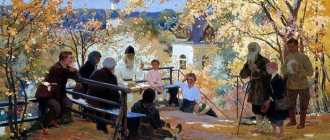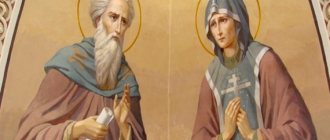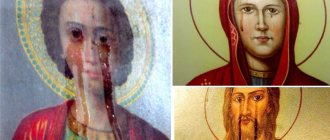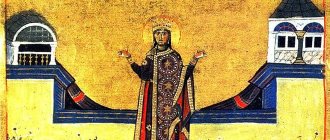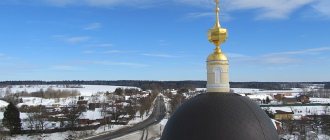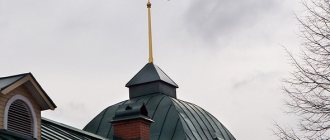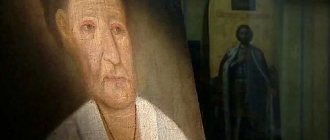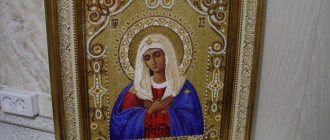| Mother Maria (Skobtsova) |
Maria (Skobtsova)
(1891 - 1945), nun, poet and author of religious articles, martyr Memory of July 20 (Const.)
In the world, Skobtsova Elizaveta Yuryevna, nee Pilenko, in her first marriage - Kuzmina-Karavaeva, was born on December 8, 1891 in Riga in the family of a Crimean landowner. I spent my childhood and adolescence near Anapa. There, her father, a talented amateur agronomist and later director of the Nikitsky Botanical Garden in Crimea, had a small estate with a vineyard. After the death of her father in 1906, the family finally moved to St. Petersburg, where Lisa entered a private gymnasium. At the age of 15, she became interested in literature and art, attending literary evenings, at one of which Blok spoke. Thus began a friendship. She was 15 years old, and the famous poet was 25. Subsequently, they corresponded for many years.
After graduating from high school, she entered the philosophy department of the Bestuzhev Courses [1].
At the age of 18, she married a lawyer, a member of the Socialist Revolutionary Party D.V. Kuzmin-Karavaev, a close friend of many writers, who later became a Catholic priest. During their short marriage, Elizaveta Yuryevna delved into religious searches, and the spirit of Christianity became more and more established in her.
She wrote poetry and participated in the literary and artistic life of St. Petersburg, visited V. Ivanov’s “tower” and A. Blok’s circle. In 1912 she published her first collection of poems.
She separates from her husband and in 1913 leaves with her daughter Gayana for her native Anapa, where she settles on the family estate. Here she experiences the beginning of the revolution and meets her future husband, Daniil Skobtsov.
Before the revolution, she was a member of the Socialist Revolutionary Party and sympathized with the revolutionary events. In 1918 [2] she was the mayor of Anapa. In Moscow, she participated on the side of the Socialist Revolutionaries in actions against the Bolsheviks.
In March 1919, she was arrested in the South by white troops and sentenced to two weeks in prison.
She emigrated through Tiflis to Constantinople with two children and D.E. Skobtsov, where she married him. In Istanbul, she gives birth to another daughter, Nastya, who died at the age of two.
In 1920 [3] she moved to Serbia.
| Prmts. Maria (Skobtsova). Icon |
In 1923, she settled in Paris with her family.
Active member of the Russian Student Christian Movement (RSCM), participant in its first congresses. In 1930, she was elected local secretary in France for work in the French province.
Since the late 20s in Paris, she began to help everyone who needed support and help. Elizaveta Yuryevna began to strive for monasticism as selfless service to the Lord and people. She was under the jurisdiction of Metropolitan Evlogy (Georgievsky).
On March 7, 1932, she received a church divorce.
In March 1932, she was tonsured a monk by Metropolitan Evlogii. When she was tonsured, she received a name in honor of Saint Mary of Egypt.
In 1932 she founded a hostel for single women in Paris (9, villa de Saxe). Two years later the hostel moved to 77 Lourmel Street.
In 1933, she participated in the RSHD congress in Estonia. She was elected secretary of the Central Secretariat of the RSHD for missionary and social work.
In 1935, M. Maria’s daughter Gayana left for the USSR and two years later died in Moscow from dysentery.
On September 27, 1935, together with G.P. Fedotov, I.I. Fondaminsky and F.T. Pyanov, she founded the “Orthodox Cause”, a charitable and cultural-educational organization to help Russian emigrants.
In 1935, together with F. T. Pyanov and priest Mikhail Chertkov, she founded a “House of Rest” for convalescent tuberculosis patients in the town of Noisy-le-Grand, and in 1936 she opened, also with the help of F. T. Pyanov, a cheap hostel in a mansion No. 43 on the street. François Gerard (in the 16th arrondissement of Paris), which became a branch of the central hostel on the street. Lourmel. She founded a canteen for the unemployed in Paris.
Then, in 1936, at the hostel on the street. Lourmel was organized a church in the name of the Intercession of the Blessed Virgin Mary and courses for psalm-readers, and in the winter of 1936 - 1937. - missionary courses.
She visited mentally ill people in hospitals.
After the outbreak of World War II, she took part in the activities of the French Resistance. With the beginning of the occupation of Paris, the house that she founded on the street. Lourmel, 77, becomes one of the headquarters of the Resistance, the center of anti-fascist activity in Paris. Soviet soldiers who escaped from captivity lived in it, parcels and money were sent, and escapes were arranged. The soul of the Lurmel committee was Mother Maria.
| Venerable Martyr Nun Maria (Skobtsova) |
On February 9 or 10, 1943, together with Father Dmitry Klepinin, she was arrested by the Nazis and kept in a concentration camp at Fort Romanville, then in the Compiegne camp, and from there she was taken to Germany to Ravensbrück.
O. Dimitri and her son Yuri Skobtsov were sent to Buchenwald. She was executed on March 31, 1945 in the Ravensbrück concentration camp in a gas chamber. There are several versions of her death. According to one version, Mother Maria went to the gas chamber instead of one of the women selected by the Nazis. According to another, she suffered from dysentery and was hidden for a long time, but was finally discovered at the end of March. She could not stand on her feet, she was so weak. The next day she was sent to the gas chamber.
In 1985, Mother Mary was posthumously awarded the title “ Righteous Among the Nations”
» [4].
In 1992, in the village of Yurovka near Anapa, at the grave of the ancestors of Mother Maria, a symbolic burial of ashes from the Ravensbrück concentration camp took place.
On February 9, 2003, a memorial plaque was installed on the site of Mother Maria’s former dormitory - the Orthodox Cause house [5].
On January 16, 2004, the Holy Synod of the Orthodox Church of Constantinople canonized Mother Mary.
She was a poet, artist, philosopher, and an excellent embroiderer. But, having taken monastic vows, she devoted all the talent of her soul, all her strength and love to helping her neighbors and the disadvantaged.
According to Nikolai Berdyaev: “ In the personality of Mother Mary there were traits that are so captivating in Russian holy women - an appeal to the world, a thirst to alleviate suffering, sacrifice, fearlessness
.»
“If you report to the Gestapo, they will let him go.”
But there was an opportunity to escape: when the Gestapo came for her son, Maria’s mother was not in Paris. But as soon as she was informed that Yura had been arrested, but he could be released in exchange for her, an active participant in the French Resistance, she immediately returned to the city. Her son is all she has left. Daughter Nastenka died back in 1926. The eldest, Gayana, on the advice of Alexei Tolstoy, returned to Russia, fell ill with typhus and also died in 1936...
Even after the death of her youngest daughter, mother Maria wrote: “I saw before me a different path and a new meaning of life: - to be the mother of everyone, everyone who needs maternal help, protection, protection ...”
And here is my own son! She, without hesitation, came to the Germans. But they did not let go of either her or Yura. The last time they met was in the Compiegne transit camp.
View of the camp during World War II from the tower
A witness to this meeting, I. N. Webster, recalled: “Some kind of golden light fell from the east onto the window, in the frame of which stood Mother Mary in black, monastic clothes, her face glowed, and the expression on her face was one that cannot be described, not all faces even once in a lifetime they are transformed like this. Outside, under the window, stood a young man, thin, tall, with golden hair and a beautiful, clean, transparent face, against the backdrop of the rising sun. Both mother and son were surrounded by golden rays... They spoke quietly. The world did not exist for them. Finally she bent down and touched his pale forehead with her lips. Neither mother nor son knew that this was their last meeting in this world. For a long time afterwards she stood alone at the window and looked into the distance. Tears slowly flowed down her cheeks."
Mother Maria never found out that before being sent to Douro-Mittelbau - a branch of the Buchenwald concentration camp, one of the most difficult camps in Germany - her Yura, 23-year-old subdeacon Georgy Skobtsov, was offered to join Vlasov’s army. But he categorically refused, and in February 1944 he died in a concentration camp from blood poisoning.
essays
- Kuzmina-Karavaeva, E.
Scythian shards. - St. Petersburg: Workshop of Poets, 1912. - Kuzmina-Karavaeva, E. (Mother Mary)
Harvest of the spirit / Compilation, preparation of texts, notes - A. N. Shustov. - St. Petersburg: Art-SPB, 2004. - ISBN 5-210-01543-2. - Kuzmina-Karavaeva E. Yu.
How I was a mayor // Will of Russia. - 1925. - No. 4. - P.63 - 80; No. 5. - pp. 68-88. - Maria (Skobtsova), mother.
“Here is a bare bush, but here is a hungry beast...” // Journal of the Moscow Patriarchate. - 1988. - No. 3. - P. 77. - Maria (Skobtsova), mother.
Types of religious life // Bulletin of the Russian Christian Democracy. - 1998. - No. 178. - Kuzmina-Karavaeva E. Yu.
Russian Plain / Compilation, introductory article, notes - Shustov A. N. - St. Petersburg: Art - St. Petersburg, 2001. - ISBN 5-210-01541-6. - Maria (Skobtsova), mother.
The present and future of the church. What is churchliness? - K.: Quo vadis, 2010. - P. 252. - Mother Maria (Skobtsova; Kuzminina-Karavaeva E. Yu.) // Saving beauty: painting, graphics, embroidery / Compiled and author Ksenia Krivosheina, foreword by Metropolitan Kirill of Smolensk. afterword by prof. Georges Nives (France); notes, chronicle of the life of mother Maria - Shustov A. N. - St. Petersburg: Art-SPB, 2004. - ISBN 5-210-01573-4.
- See also bibliography up to 2000 - Date of access: 09/25/2017.
Time to search
Her life before becoming a monk resembled an intricate quest or a motley mosaic in the Art Nouveau style. Hereditary noblewoman Elizaveta, by Skobtsov’s second husband, was born in Riga, spent her childhood near the Black Sea, where her father, Yuri Pilenko, having inherited an estate near Anapa, took up industrial winemaking, and in 1905, having moved with his family to Crimea, became director of the Nikitsky Botanical Institute garden A year later, carried away by Stolypin’s reform ideas, he completely decided to become an employee of the Main Directorate of Land Management and Agriculture and move his family to St. Petersburg, but he suddenly died of kidney disease.
His widow and children eventually moved to the capital. Elizaveta entered the philosophy department of the historical and philological faculty of the Higher Bestuzhev Courses, met Blok, married Dmitry Kuzmin-Karavaev, a regular in the capital’s literary salons, and spun into the whirlwind of bohemian life. Her circle of friends includes Gumilyov, Akhmatova, Mandelstam, Lozinsky, Voloshin, Alexey Tolstoy, Vyacheslav Ivanov. She herself, like everyone around her, wrote poetry and even published collections.
Elizaveta Skobtsova
And then a leapfrog of wars and revolutions began, and Lisa turned from a bohemian diva into a fiery fighter for justice. She managed to get a divorce, leave St. Petersburg for Anapa, she already had a daughter, but this did not stop her from rushing into the thick of the political struggle: in March 1917, she joined the Socialist Revolutionary Party. And in 1918, she even briefly became the mayor of Anapa, and then the Commissioner for Health and Public Education. Tried to protect people from robbery and terror, and cultural values from looting. For this commission, the whites later arrested her and almost executed her - she was saved by the intercession of Maximilian Voloshin, Alexei Tolstoy and Vera Inber.
And then Lisa married the judge who sentenced her, and became Skobtsova... In general, not fate, but a real film script.
Exile
Elizaveta Yuryevna’s tossing and wanderings ended predictably - in emigration. Georgia, Constantinople, Serbia, Paris... There, in the “capital of the world,” no one cared about her poetic talents, she had to publish advertisements in newspapers like: “I clean, wash, disinfect walls, mattresses, floors, remove cockroaches and other parasites.” . And actually go to apartments and remove bedbugs there. Elizabeth also sewed, painted fabrics, made dolls, mastered carpentry and painting, milked cows, typed... And at the same time she published in emigrant magazines, participated in meetings of Christian youth and attended theological courses. She met the most prominent Russian religious philosophers and theologians - Nikolai Berdyaev, Georgy Fedotov, Konstantin Mochulsky, Ilya Fondaminsky, and Archpriest Sergius Bulgakov became her spiritual father.
Finally, spiritual quests, the desire to serve the Church and help compatriots cut off from their homeland led Elizaveta Skobtsova to the Russian Student Christian Movement, an organization that helped emigrants. As her traveling secretary, she gave lectures throughout France, and then wrote articles about the difficult life of emigrants.
Once in a small mining town, speaking in a workers’ barracks, Elizaveta Yuryevna heard from a tired, irritated worker: “It would be better if you washed the floors for us here than read reports!” - and without hesitation, she took a rag and began to wash the floor. And when she finished, she only asked: “Remind me where we left off?” The embarrassed workers sat her down at the table, brought her lunch... And the conversation took a completely different tone: it turned out that one of the miners was on the verge of suicide. Elizabeth took him to his friends, and he was able to regain his mental strength and return to life.
tonsure
After the death of her youngest daughter, Elizaveta Yuryevna decided on a church divorce from her husband in order to completely devote her life to serving others for the glory of God. And with the blessing of her spiritual father and Metropolitan Eulogius (Georgievsky), she took monastic vows with the name Maria - in honor of Mary of Egypt. Thus ended the intricate quest of Liza Pilenko - Kuzmina-Karavaeva - Skobtsova, and monasticism began in the world.
According to her father Boris Stark, who personally knew her, “the cassock for her was skin, not a camouflage suit. For Mother Mary, love for God and love for people were inseparable.”
During the Civil War, Elizaveta Yurievna defended the city
In the conditions of the Civil War and the change of power, Elizaveta Yuryevna was constantly looking for ways out of difficult situations.
Under the Reds, she defended the city and saved cultural values. When the city was captured by the White Guards, she was arrested, accused of conspiring with the Reds. She faced the death penalty.
But thanks to competent defense in court, she was arrested for only 2 weeks. The outcome of events was largely influenced by Daniil Ermolaevich Skobtsov, a prominent figure in the Kuban Cossack movement. After the trial, Elizaveta Yuryevna became his wife.
Daniil Ermolaevich Skobtsov. Husband of Maria Skobtsova. A prominent figure in the Kuban Cossack movement. Thanks to his connections and influence, Maria Skobtsova was released from arrest and not subjected to the death penalty
House on Rue Lourmel
The life of emigrants in Paris in the 1930s was hunger, unemployment and lack of money. And Mother Maria creates for them in house 77 on Lourmel Street a shelter, a new type of Christian community - half brotherhood, half monastery with the Church of the Intercession of the Blessed Virgin Mary in the garage. Homeless people, the sick, drug addicts, single women and alcoholics, cripples who had lost their human appearance and former patients of insane asylums who, not knowing French, could not even communicate with doctors found shelter there... And they all needed sympathy, decent care, treatment, normal food, and just a roof over your head.
Mother Maria bought food for her charges at the Central Market of Les Halles, immortalized by Emile Zola in the novel “The Belly of Paris.” She desperately bargained with the sellers, and they gave her big discounts, and sometimes even gave her their unsold perishable goods for free. But the nun was in no hurry to leave the market - she wandered with her cart from one cafe to another, looked for Russians among the tramps and beggars, spoke to them, listened to their confused, often tragic stories and called “to Lourmel.”
Memorial plaque on the site where the monastery with the Church of the Intercession was previously located on Lourmel Street
Mother, eldest daughter and son helped in the dining room and in the church, which Mother Maria decorated with icons, painted and embroidered by herself. She painted the chapel herself. And she embroidered the priestly vestments herself... She was not afraid of work, she took on everything - gardening, cooking, construction. She didn’t notice the cold, she could not eat or sleep for days, she despised comfort.
The head of the church administration in Paris, Metropolitan Eulogius (Georgievsky), supported her in everything. Together with priest Dimitry Klepinin and Pyotr Lopukhin, they created the charitable and educational association “Orthodox Cause” there, on Lourmel Street, and opened two hostels for the poor, a parish school, missionary and lecture courses, and psalm-reading courses. And in the suburbs of Paris they set up a rest home for recovering tuberculosis patients. The magazine “Orthodox Business” began to be published, and Mother Maria actively published in it.
She was well known in Paris - she was bright and strange. She didn’t pay attention to her clothes—a dusty, stained cassock and worn-out men’s shoes—perhaps because of severe myopia. And she always smiled. Appearing somewhere, she invariably filled the entire space: she spoke assertively, with conviction, forcing everyone around to believe in the absolute necessity of what she wanted to achieve at that moment. At the same time, Mother Maria was unusually patient and benevolent: she not only did not remember evil, she did not notice it! She and her loved ones were robbed many times by their own charges, and nothing happened - she quickly forgot everything, smiled and continued her service.
“The path to God lies through love for man, and there is no other way,” wrote Mother Maria. “At the Last Judgment they will not ask me whether I successfully engaged in ascetic exercises and how many prostrations I made, but they will ask me: did I feed the hungry, clothed the naked, visited the sick and the prisoner in prison. And that’s all they’ll ask.”
An occupation
In 1940, France was occupied by the Nazis. Again - hunger, devastation, despair... But Maria’s mother was no stranger: practical, energetic, she took care of food supplies for the inhabitants of the shelter on Lourmel Street - she secured a document that her almshouse, under the auspices of the authorities, was becoming a municipal canteen, and began to receive food from the city hall and food cards. And most importantly, her charges were safe.
But the persecution of Jews began. Mother Mary expressed her position decisively and firmly: “There is no Jewish question, there is a Christian question. Don’t you understand that the struggle is against Christianity?.. Now the time has come for confession.”
And the shelter on Lourmel Street became a refuge for Jews, escaped Soviet prisoners of war and French anti-fascists. They were hidden here, they made false documents, false baptismal certificates, they helped them move to the “free zone”, they accommodated children whose parents were captured during raids. Mother Mary developed a close connection with the French Resistance. Sympathizers of the “Orthodox Cause” compiled lists of prisoners—Russian and Jewish—and sent them letters and parcels.
On the night of July 4–5, 1942, 13 thousand Jews were arrested in France. They were taken to a winter velodrome near Rue Lourmel. Thanks to her monastic robe, Mother Mary managed to get there. She spent three days there, comforting a Jewish friend, helping Red Cross volunteers provide aid to the sick, supporting adults and children, distributing provisions... And managed to save four children by hiding them in garbage boxes - confirming her words with deeds: “I think that a man may renounce any of his rights, but absolutely dare not renounce his neighbor.”
In a concentration camp
In the winter of 1943, when her son was arrested, a Gestapo man came to the shelter on Lourmel Street, well aware of the connection between the “Orthodox Cause” and the Resistance, interrogated his mother Maria for a long time, ordered her to get ready, and reproached her mother, Sofia Borisovna: “You are bad.” raised your daughter, she only helps the Jews!” But she calmly answered: “My daughter is a true Christian, and for her there is neither a Greek nor a Jew, but an unfortunate person. Even if you were in trouble, it would help you too.” And Mother Maria smiled: “Perhaps she would help.” The German decided that they were making noise at him, swung at the nun and almost hit her. But she was telling the truth...
The chairman of the “Orthodox Cause”, destroyed by the fascists, was first placed in the Fort de Romainville camp near Paris, then transferred to the Compiegne camp, where she saw her son for the last time, and finally, in a cattle car, she was brought to the Ravensbrück women’s concentration camp. Here Mother Mary was to spend the last two years of her life.
What was she doing in the camp barracks? Yes, the same as before the arrest: she prayed, helped the weak, supported the desperate, cared for the sick, fed the hungry... Yes, yes, she shared precious food, which was monstrously little, with those who had it worse. After work and roll calls, I went to other barracks. One of them housed prisoners from the Soviet Union. Prisoner of Ravensbrück Rosan Laskru recalled: “Some were sent to work in factories - others came to replace them. I don’t know what exactly Mother Maria told them, but she spoke to them in such a way that they left enlightened.”
And here are the memories of Charles de Gaulle’s niece, Genevieve de Gaulle-Antonoz, also a former prisoner of Ravensbrück: “On her mattress she organized real circles, where she talked about the Russian revolution, about communism, about her political and social experience and sometimes, more deeply, about your religious experience. Mother Maria read excerpts from the Gospel and epistles from the “Christian Handbook,” which one of the prisoners had saved during the search. She interpreted what she read in a few words. We prayed next to her and sometimes sang in a low voice. Mother Maria often visited the block of Russian “soldier” girls, who received her with love. She told us with admiration about their courage. Perhaps in these young faces she found the face of her daughter Gayana, who married a Soviet student and died in Russia.”
Camp Ravensbrück
Firmness and resilience helped Mother Maria not only survive in the concentration camp, but be a support for other prisoners. Calm, resilient, courageous, she faced death more than once in her life and, in anticipation of the resurrection of the dead, was not afraid of her own death.
Here's another piece of evidence. Prisoner Jacqueline Peyrie recalls: “Everyone in the block knew her well, she got along well with both young and old, with people of different political views and with people of completely different beliefs. She told us about her social experience in France. We asked her about the history of Russia, about its future... These discussions were for us a way out of our hell. They helped us restore lost spiritual strength, they rekindled in us the flame of thought, barely smoldering under the heavy oppression of horror.”
I want to quote memories of Mother Maria again and again. Solange Peirichon said: “She was never depressed, never, She never complained […]. She was funny: really funny. We had roll calls that lasted a very long time: we were woken up at three in the morning, and we had to wait in the open air in the dead of winter until all the barracks were counted. She took it all calmly and said: “Well, another day is done. And tomorrow we will repeat the same thing. And then one fine day will come when all this will be over."
Since April 1943, the furnaces of the Ravensbrück crematorium worked two days a week, and by 1945 they switched to round-the-clock operation. It seems that it is impossible to imagine a sight more terrible than its smoking chimneys, but Mother Maria said: “Only here, above the chimney itself, the clouds of smoke are gloomy, and when rising upward, they turn into a light cloud, and then completely dissipate in the boundless space. So our souls, having torn away from the sinful earth, go into eternity in a light unearthly flight for this joyful life.”
Meanwhile, in the inhuman conditions of the camp, the health of Maria’s mother deteriorated every month. Her legs were swollen, and she could no longer stand without assistance. Then she could no longer sit - she lay down. But at the same time I managed... to embroider! One of her embroideries from 1944 has miraculously survived to this day: it symbolically depicts the Allied landing in Normandy. Rosan Laskru says: “She embroidered during roll call, almost without looking, without drawing […], with a “Kyiv” seam, Matter is my camp scarf […]. The paints were supplied by a Polish friend who worked on dyeing SS shirts. We obtained threads from windings of electrical wires, cut and stripped using Siemens camp machines. The needle was stolen from the German tailor's workshop of Binder Uhl, the torturer. The fellow prisoners carried all this at risk to their lives so that the embroidery - this masterpiece - could be created.”
Our Savior Not Made by Hands, embroidered by Maria (Skobtsova)
In 1945, Mother Maria, according to her fellow prisoners, “no longer belonged to the kingdom of the living”: she did not get up, almost did not speak, could not open her eyes from exhaustion... She asked E. A. Novikova to remember and pass it on to Bishop Eulogius and Father Sergius Bulgakov his last message: “My condition now is that I have complete submission to suffering, and this is what should be with me, and that if I die, in this I see a blessing from above.”
She, as unable to work, was transferred to the Jugendlager a kilometer from Ravensbrück - a death camp for the weakened, sick and elderly. There was almost no food there. Roll calls - twice a day in any weather - could last for five hours. The prisoners were stripped of their blankets, then their coats, and finally their stockings and boots. And this is in winter. Instead of beds there are wet bags of straw, there are no stoves. There were no toilets, and dysentery reigned in the barracks. And instead of medicine they gave poison. They shot and gassed me every day. And the slopes of the nearby hills were fertilized with ashes from the crematorium.
Mother Mary turned into a skeleton covered in skin. She fell ill with dysentery, her eyes festered. But she not only lived in Jugendlager for five whole weeks, but also continued to embroider - the Mother of God with the Child Christ. She traded the threads for bread. And she categorically refused to give up the icon after the work was completed, although many asked. She said: “Let’s go back to Paris, I’ll give it away for free, I’ll give it as a gift, but not here. If I manage to finish it, it will help me get out of here alive, but if I don’t have time, it means I’ll die.”
Did not make it. In February 1945, she and the few surviving prisoners were returned to the main camp. She had just over a month to live.
Aleksandr_Blok_1907g.jpg
Meeting with Alexander Blok
in December 1907 Lisa’s cousin, Olga Shchastlivtseva, wanting to knock her “out of the rut of pathetic melancholy and belief in nonsense,” invited her to one of the poetry evenings. In her memoirs on the fifteenth anniversary of A. Blok’s death, M. Maria writes: “I was a “decadent” for her. Out of the kindness of her heart, she decided to take care of me. And do it not in your own spirit, but in my own spirit. One day she took me to a literary evening at some provincial real school, somewhere in the Izmailovo companies. Each capital has its own province, so here there was its own Izmailovo-company, real school - province. There are a lot of young people in the recreation hall. Decadent poets read poetry. There are quite a lot of them. One is tall, chinless, with a huge nose and straight strands of long hair, in a long frock coat, reading cheerfully and with a lisp. They say this is Gorodetsky. The other is Dmitry Censor, I don’t remember his face. I don’t remember some others. And one more. Very direct, a little arrogant, voice slow, tired, metallic.
Dark copper hair, a face not modern, but as if from a medieval tombstone, carved from stone, beautiful and motionless. He reads poetry, obviously new, “in the evenings, above restaurants”, “The Stranger”... and reads some more.
There is great attention in my soul. A man with such a distant, indifferent, beautiful face. It's not at all like the others. There is something unprecedented in front of me, head and shoulders above everything I know. Something noted... There is a lot of melancholy, hopelessness in the poems, many voices of terrible Petersburg, red fog, city suffocation. They are not outside of me, they sing within me, they are like my poems. I already know that HE owns the secret that I am wandering around, which I have almost encountered so many times during my wanderings around the islands of this city.
I ask my cousin: “Look in the program - who is it?”
Answers: “Alexander Blok.”
M. Voloshin also recalls the poet’s strange, hypnotizing manner of reading poetry: “He himself reads his poems slowly, measuredly, clearly, in his even, matte voice. His recitation unfolds sternly, calmly, like a series of plaster bas-reliefs. Everything is shaded, built precisely, but there is not a single color, just like in his marble face. Deliberate dullness and indifference cover his reading, hiding, perhaps, too intimate awe invested in the poems. This plaster bas-relief gives special weight and modesty to his reading."
During this dark red, endlessly cold period of her life, which turned from months into years of melancholy, a miracle happened! The next day she found a book of Blok’s poems, read it and realized that it would be forever. She heard not only a voice, but also met a kindred spirit: “I don’t understand... but I also understand that he knows my secret. I read everything this young poet has. <…> I am truly in an unprecedented world. I write myself, I write about melancholy, about St. Petersburg, about heroism, about the people, about death, about melancholy and... about delight!”
She was 16, the poet was almost 30.
The poems, Blok’s whole appearance, consonant thoughts, gave birth in her head to the absolute confidence that he is the living embodiment of the Sage. He knows the innermost secrets of the world, he foresees and will certainly be able to answer the questions that tormented her. There is no doubt that she fell in love with him at first sight, it was the love without modesty of a well-bred young lady, it was not the love of fans of the talents of great singers and actors, no, it was a meeting of her second self, which miraculously was sent at a desperate moment in life to her salvation.
Martyrdom
Several former prisoners have memories of Mother Maria’s last day. Some write that she was not included in the number of suicide bombers, but she saw the panic on the faces of the doomed and tried to calm them down, and then simply joined them. Others argue that Mother Maria, given her condition, was sentenced from the very beginning, but agree that she could well have voluntarily taken the place of one of her unfortunate fellow prisoners. “Be that as it may, she consciously sacrificed herself, thereby helping each of us to accept our cross,” writes Jacqueline Peyrie.
On January 16, 2004, nun Maria (Skobtsova) was canonized by the Patriarchate of Constantinople as a venerable martyr. A true Christian, she understood that by saving people, she was exposing herself to mortal danger. But she couldn’t do it any other way. Metropolitan Anthony of Sourozh said about her: “She lived in the soul- and flesh-tearing contradictions of compassion and responsible bearing of her Christian name: in love for the sake of Love, in dying for the sake of Life, in giving her life for the sake of the truth of the Kingdom of God. Her image will become brighter and brighter, her spiritual significance will increase for us as we begin to understand the final meaning of Love embodied and crucified.”
In 2016, a street named after Mary’s mother was opened in Paris - it is adjacent to the same Lourmel street...
pathological speech
Churchness
I think that you shouldn’t go further than the 19th century in search of the modern meaning of this word, because it is not of ancient origin. It is most likely that its ancestors were Slavophiles and, mainly, late Slavophiles. Most often it began to be used in connection with the slogan of the ecclesiasticalization of life. It was supposed, as it were, that the ecclesiasticalization of life has as its fruit ecclesiastical
the one who has taken this path.
But rarely does anyone who speaks about the ecclesiasticalization of life give an exact definition of this concept, especially the concept of churchliness
[11].
Mother of God - mother of cheese earth
- The world is protected by the protection of the Mother of God, and she is the mother of the damp earth[12].
